 The CD notes tell us that Dick Hyman made partial arrangements of these pieces, setting up a platform for improvisation. When clarinetist Ken Peplowski arrived for the recording session, he had not yet seen the arrangements, which helped to encourage spontaneity. I think I can detect the places where the music is pre-arranged, but such detection does not touch upon the essence of these performances.
The CD notes tell us that Dick Hyman made partial arrangements of these pieces, setting up a platform for improvisation. When clarinetist Ken Peplowski arrived for the recording session, he had not yet seen the arrangements, which helped to encourage spontaneity. I think I can detect the places where the music is pre-arranged, but such detection does not touch upon the essence of these performances.
After listening to the first few tracks, I was struck by something different taking place. Thinking about it, I wondered how it compared with a CD Hyman made with another treble instrumentalist—cornetist Rudy Braff—in 1991 (Younger Than Swingtime: Music from South Pacific, Concord Jazz, CCD-4445).
Listening to the older recording again after many years brought back the realization of how terrific that CD is; it also confirmed my impression about the later one. In the Braff recording, we hear a standard approach: during cornet solos, the piano provides accompaniments (in Hyman’s hands, extraordinarily imaginative accompaniments); during piano solo sections, the cornet punctuates occasionally with appropriate comments. Given the musicians involved, it’s no surprise that this standard approach provided a platform for outstanding performances. As for the difference between the two CDs, that is highlighted by the newer CD’s title: Counterpoint.
Hyman has issued many recordings on individual songwriters, as revealed in the titles: Dick Hyman Plays Harold Arlen, Dick Hyman Plays Duke Ellington, . . . Plays Fats Waller, etc. Why is the current CD not something like Hyman and Peplowski Play Lerner & Loewe? The title tells us their approach this time is not standard, but one based on contrapuntal interplays. That intent is abundantly clear in the first track, “Waitin’ for My Dearie” (from Brigadoon). The performance is not solo and accompaniment, but two instruments on the same level in almost continuous counterpoint.
“On the Street Where You Live” (My Fair Lady) retains the contrapuntal texture, but also highlights another idea. It is taken very slowly, with a single statement of the chorus filling the entire four-minute track. Within that statement, though, lies intriguingly imaginative music-making. With the exception of a few measures near the end, the melody is carried entirely by the clarinet, which stays very closely to the original tune.
Against the melody, the piano provides the countrapuntal lines and harmonies . . . but lines and harmonies that occasionally seem to be in keys other than the G‑flat tonality of the melody. Is this bitonality? Perhaps, but the term is debatable and subject to interpretation.
Darius Milhaud’s Saudades do Brazil (1920), a dance suite for piano, strongly suggests bitonality with the bass and treble parts each in different keys. But some musicians claim that only a single tonality is actually heard and that the so‑called bitonality should be interpreted as extended harmonies within that single key.
So, for example, in the first dance of the Mihaud suite, where the bass outlines a G major triad while the treble outlines an E-flat triad, instead of viewing this as a juxtaposition of two keys, the right-hand’s E-flat may be interpreted as the flat-13 above the G. I know from discussions with Hyman that this latter view reflects his thinking. Consequently, it may be more appropriate to regard those bitonally-suggestive portions of “On the Street Where You Live” as the use of extended harmonies.
While the countrapuntal view is never totally dropped, some selections recall the more traditional approach of solo with piano accompaniment. In “Gigi,” the only track on which Peplowski plays tenor sax instead of clarinet, Hyman provides a mostly homophonic accompaniment, along with melodic fill‑ins when Peplowski sustains notes. Only in a few brief places does the piano participate in a contrapuntal texture. (On a separate track, Hyman plays the same tune as an unaccompanied piano solo.) The piano is mostly a homophonic accompaniment also in the arranged portion of “I Could Have Danced All Night” (My Fair Lady), but the contrapuntal interchanges take over in the improvised sections.
The improvisational process on this CD is eloquently expressed by the artists. Peplowski is quoted in the notes: “We can take a figurative left turn in the middle of the song and instinctively know where the other is going and somehow come back.” Hyman expands upon this description: “Sometimes we go off on strange tangents and kind of dare the other fellow to understand what we’re doing or create something in contrast, just to make something come out in ways we didn’t expect.”
As a listener, I notice something new on each playing, and I’m sure I’ve missed many of these fascinating excursions into improvised counterpoint. Detecting the surprises as these two superb artists respond to each other is part of the fun and the challenge.
In 1956, a young Dick Hyman published a folio titled Dick Hyman’s Modern Jazz Duets (Counterpoint for Six Valves). More than six decades later, the still youthful Dick Hyman continues exploring the possibilities of counterpoint.
Dick Hyman & Ken Peplowski Counterpoint Lerner & Loewe
Arbors Records ARCD 19471






















